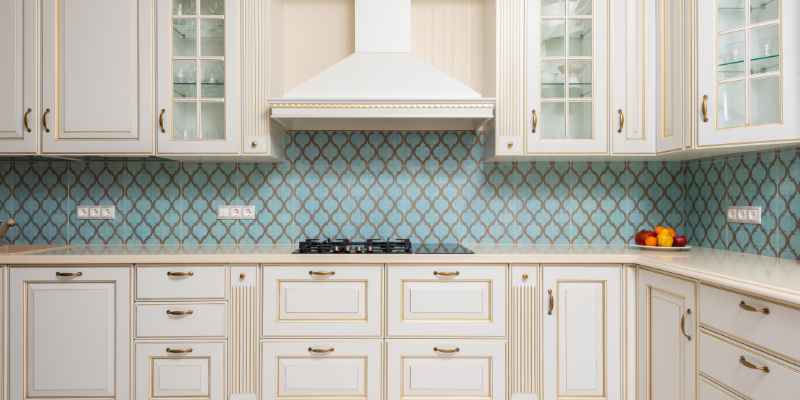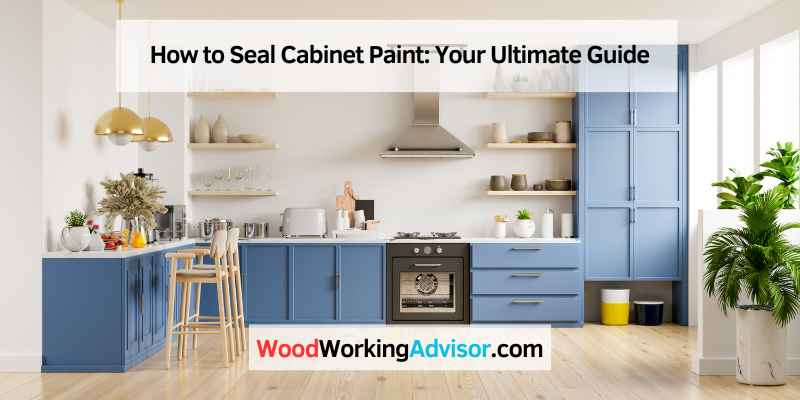To seal cabinet paint, use a clear coat like polyurethane or acrylic sealer. These water-based options provide a non-yellowing finish and protect your painted cabinets from scratches, moisture, and fading.
Adding a clear coat is important whether you have painted or stained cabinets and helps to keep them looking like new for longer. Before sealing, make sure to properly prep and clean your cabinet surfaces, prime them well, and choose a quality paint.
We’ll take a closer look at some of the best clear coat options for painted cabinets and share tips to help your cabinets last longer.
Prepping Cabinets For Sealing
Before sealing, it is essential to properly prep your cabinets. This involves thorough cleaning, sanding, and removing any dust particles. Once the surface is prepped, use a clear acrylic sealer to protect and highlight the painted surface of the cabinets.
Thorough Cleaning
Before sealing the cabinets, it is essential to clean them thoroughly. Start by removing all hardware and hinges from the cabinets. You can use a screwdriver to remove them easily. Then, use a soft cloth and a mixture of warm water and soap to clean the cabinets. Rinse the cabinets with clean water and allow them to dry thoroughly before proceeding to the next step.
Sanding Cabinets
After cleaning the cabinets, sanding them is mandatory. It is necessary to remove any glossy finish on the cabinets, obtain a smooth surface, and allow the primer to adhere better. You will need to use 100-grit sandpaper to sand the cabinets. Start by sanding the cabinet surface with the sandpaper, making sure to work in the direction of the grain. Clean any dust from sanding with a tack cloth before applying your primer.
Choosing The Right Primer
Choosing the right primer is crucial when sealing your cabinets. The primer should match the paint type, and it should be compatible with wood surfaces. A primer with good adhesion properties is critical as it will help the paint adhere to the surface better, thus guaranteeing a long-lasting finish. If you are painting over a dark wood, it’s a good idea to use a stain-blocking primer to prevent the wood’s color from showing through the paint.
Remember that preparing your cabinets properly before sealing is the key to a long-lasting and beautiful finish. Clean the cabinets thoroughly, sand them down, and choose the right primer to guarantee a smooth and even finish for your cabinets.
Painting Cabinets
Sealing painted cabinets is necessary to protect them from moisture, heat, and other factors that can damage the paint. Acrylic sealers are the best choice for a clear and non-yellowing finish to preserve the beauty of your painted cabinets. Proper prep work, cleaning, priming, and the use of quality paint are essential for the long-lasting durability of your painted cabinets.
Painting cabinets is a cost-effective way to give your kitchen a fresh, new look without replacing the entire cabinetry. However, to ensure the longevity of your painting efforts, it is crucial to seal the cabinet paint properly. In this post, we will discuss techniques for applying paint, recommended types of paint, and the difference between spray and hand painting.
Techniques for Applying Paint
When it comes to painting cabinets, there are several techniques for applying paint, such as brushing, rolling, and spraying. Brushing is a common method for painting cabinets with a brush, and it is suitable for corners, edges, and ornament details. Rolling is the quickest technique that gives a smooth finish to large surfaces, such as cabinet doors. Finally, spraying is the most professional-looking technique that gives the smoothest finish; however, it requires more equipment and technique to avoid overspray.
Recommended Types of Paint
Not all paints are suitable for cabinets. Some types may cause chipping or peeling, and some may not adhere well. Therefore, it is essential to choose the right paint type for your cabinets. Two main types of paint that are suitable for cabinets are oil-based and water-based paints. Oil-based paints are durable and resistant to wear and tear, but they take longer to dry and may emit harmful chemicals. Water-based paints are easy to clean, have low odor, and dry faster than oil-based paints; however, they are less durable.
Spray vs. Hand Painting
The difference between spray and hand painting is the technique used to apply the paint. Spray painting uses a sprayer to apply paint on surfaces, whereas hand painting uses a brush or a roller. Spray painting gives a smoother finish with no brush marks, but it requires more equipment, skills, and technique to avoid overspray. Hand painting is more suitable for corners, edges, and ornament details, but it may result in brush marks that lower the quality of the finish.
In conclusion, painting cabinets is a cost-effective way to give your kitchen a fresh look. However, it is crucial to seal the paint to ensure it remains good-looking for the long-term. In this post, we have discussed the techniques for applying paint, recommended types of paint, and the difference between spray and hand painting. By following these tips, you can achieve a professional-looking finish on your painted cabinets.
Clear Coating Cabinets

Sealing cabinet paint with clear coating is a great way to protect and extend the life of your cabinets. A clear coat also adds a smooth finish to the paint job. Using an acrylic sealer is recommended for a clear and non-yellowing finish.
Clear coating cabinets is an essential step in preserving the paint and ensuring that your cabinets last long. Clear coating not only protects the paint from water damage and staining but also adds a glossy finish to the cabinets, making them look more attractive and polished. In this section, we will discuss the benefits of clear coating cabinets, types of clear coat, and application tips for a perfect finish.
Benefits of Clear Coating
Clear coating your cabinets comes with several benefits such as protection from moisture damage, scratches, and wear and tear. It also adds a glossy and smooth finish to your cabinets, making them look more attractive and polished. Clear coat prevents the paint from fading, chipping, or peeling off. It is an essential step in ensuring that your cabinets last long and maintain their quality and beauty.
Types of Clear Coat
There are different types of clear coats available in the market, each with its own unique features and benefits. The most common types of clear coat used for cabinets are polyurethane, varnish, and lacquer. Polyurethane is a water-resistant, durable, and easy-to-apply clear coat suitable for high-use areas. Varnish is an oil-based clear coat that offers excellent protection against scratches and stains. Lacquer is a fast-drying, high-gloss, and durable clear coat suitable for cabinets made of wood or MDF.
Application Tips
Before applying the clear coat, ensure that the cabinets are clean, dry, and free from debris or dust. Sand the cabinets lightly to ensure that the surface is smooth and even. Apply the clear coat using a good quality brush, roller, or spray gun. If spraying, ensure that you cover other surfaces to avoid overspray. Apply multiple thin coats, allowing each coat to dry thoroughly before applying the next one. Sand lightly between each layer to ensure that the surface is smooth and even.
Conclusion
Clear coating your cabinets is an essential step in ensuring that they last long and maintain their quality and beauty. There are different types of clear coat available in the market, each with its own unique features and benefits. Applying the clear coat requires careful preparation and attention to detail to achieve a perfect, glossy finish that adds value to your cabinets.
Sealing Painted Cabinets
When painting cabinets, it is important to seal the painted surface to protect it from wear and tear. Applying an acrylic sealer or clear coat over the paint can help to keep the cabinets looking like new for longer. Additionally, thorough cleaning and prepping, as well as using quality paint, can also help to prevent peeling and ensure that the paint lasts for a long time.
Sealing painted cabinets is an essential step in protecting the paint from scratches, stains, and other external factors that can cause damage. While many homeowners believe that painting cabinets is where the hard work ends, sealing the paint is an equally crucial step. In this article, we will discuss the benefits of sealing paint, types of sealants to use, and application tips to ensure a flawless finish.
Benefits Of Sealing Paint
Sealing paint on cabinets helps to protect the painted surface from scratches, stains, and wear and tear. It also helps to extend the lifespan of the paint, so it lasts longer before needing a touch-up. Furthermore, sealing cabinets provides a protective barrier that is easy to clean, making your cabinets remain beautiful for longer.
Types Of Sealants
There are different types of sealants available in the market, ranging from oil-based to water-based sealers. Oil-based sealants are an excellent option for sealing cabinets, as they are durable, strong and can resist chipping, fading, cracking, and peeling. However, they tend to give off fumes and release volatile organic compounds (VOCs) that can be harmful to health. Water-based sealers, on the other hand, are safer and environmentally friendly options, and they dry quickly. However, they are less durable than oil-based sealers and may not offer as much protection.
Application Tips
To ensure a perfect finish, it’s essential to follow these tips when applying the sealant:
- Ensure that the painted cabinets are clean and dry before applying the sealant.
- Choose a high-quality sealant that is specifically designed for cabinets.
- Use a clean, dense and smooth foam roller to apply the sealant on the surface of the cabinets.
- Avoid using a brush as it may leave bristles on the painted surface.
- For best results, apply two to three thin coats of sealant, allowing each coat to dry before applying the next coat.
- Be sure to follow the manufacturer’s instructions for the best application results.
In conclusion, sealing painted cabinets is a crucial step in the cabinet painting process. It helps to protect the paint from damage, extend the lifespan of the cabinets and make them easier to clean. By understanding the benefits of sealing paint, types of sealants available, and application tips, you can ensure that your painted cabinets remain beautiful and durable for years to come.
Maintaining Sealed Cabinets
To ensure longevity of painted cabinets, it is important to properly seal them. The best sealant to use is an acrylic sealer, which provides a clear, non-yellowing finish. It helps protect the cabinets from damage, whether they are painted or stained.
Once you have applied a sealant to your painted cabinets, it is important to maintain that seal in order to keep your cabinets looking pristine for years to come. Here are some tips for cleaning and caring for your sealed cabinets, as well as avoiding scratches and damage.
Cleaning And Care
To keep your sealed cabinets looking their best, it’s important to clean and care for them regularly. Avoid harsh or abrasive cleaning products, as well as anything that might scratch or damage the sealant. Instead, use a soft cloth and a mild, non-abrasive cleaner or simply warm water. You can also an add a few drops of dish soap to your warm water for a deeper clean. Be sure to dry your cabinets thoroughly to prevent any moisture from seeping into the wood or the sealant.
Avoiding Scratches And Damage
While sealed cabinets are more durable than unsealed cabinets, they are still susceptible to scratches and damage if proper care is not taken. Avoid placing sharp or heavy objects on your cabinets, as well as dragging items across them. Use non-slip mats or liners in your cabinets and drawers to prevent items from shifting and potentially scratching the surface. If you need to move items in your cabinets, gently lift and relocate them rather than dragging them across the surface.
Overall, maintaining sealed cabinets is a relatively easy process that can help to keep your cabinets looking their best for years to come. With proper cleaning and care, and by taking steps to avoid scratches and other damage, you can ensure that your sealed cabinets continue to look beautiful and functional for many years to come.
DIY Vs. Professional Cabinet Sealing
When it comes to sealing your cabinet paint, you might be wondering whether to go for a DIY approach or hire a professional. DIY cabinet sealing might save you money, but a professional might do a better job for a more long-lasting finish.
It’s crucial to weigh up the pros and cons before making a decision.
Pros And Cons Of Diy Sealing
Sealing your freshly painted kitchen cabinets is essential to protect them against moisture, scratches, and heavy use. But the question is, should you take the DIY approach or hire a professional? Here are the pros and cons of sealing your cabinets yourself.
Pros:
Cons:
– Requires significant time and effort
– May not be as effective as professional sealing
– No guarantee of quality results
If you choose to seal your cabinets yourself, make sure to select a high-quality sealer that is compatible with your cabinet’s paint. Follow the manufacturer’s instructions closely, and apply the sealer in thin, even coats. Give each coat enough time to dry before applying the next one, and sand lightly in between coats to achieve a smooth finish.
Costs Of Professional Sealing
Hiring a professional to seal your kitchen cabinets can ensure a high-quality finish and save you time and effort. However, it comes with a cost. Here is an idea of what you can expect to pay for professional sealing:
Cost Factors:
– Cabinet size and number
– Type of sealer used
– Labor costs
On average, cabinet sealing by a professional can cost between $500 to $1000 or more, depending on the size and condition of your cabinets. Keep in mind that this price may increase if your cabinets require additional prep work or repairs.
In conclusion, sealing your cabinets is an important step in preserving their beauty and durability. Whether you decide to DIY or hire a professional, make sure to carefully consider your options to ensure the best results for your kitchen.

Frequently Asked Questions For How To Seal Cabinet Paint
What Is The Best Sealant For Painted Cabinets?
Acrylic sealers are the best sealants for painted cabinets, providing a clear, non-yellowing finish. Clear coats also help protect painted or stained cabinet doors and drawer fronts from scratches, moisture, and fading. A polyurethane or epoxy sealant can also be used.
Adding a clear coat is recommended to extend the life of painted kitchen cabinets. Thorough prepping, cleaning, and high-quality paint selection is necessary to prevent peeling or damage.
Do Painted Cabinets Need To Be Sealed?
Yes, painted cabinets should be sealed to protect the finish. You can use a clear coat like polycrylic or polyurethane to seal the cabinets and provide added durability. Sealing the cabinets will protect the paint from scratches, moisture, fading, and other types of wear and tear.
Acrylic sealers are often used to protect painted surfaces and cabinets.
How Do You Keep Paint From Peeling Off Cabinets?
To prevent paint from peeling off cabinets, follow these tips: thoroughly prep and clean the surfaces, use quality paint and primer, and add a clear coat. You can also seal your cabinets with a polyurethane or epoxy sealant to protect against moisture, scratches, and fading.
Consider using acrylic sealers for a clear and non-yellowing finish. Avoid excess paint buildup and remove any sanding dust before applying the paint. Finally, take the doors off and use good quality brushes or rollers for a smooth finish.
Can You Clear Coat Over Cabinet Paint?
Yes, you can clear coat over cabinet paint. Adding a clear coat to painted cabinets helps protect the finish from moisture, scratches, fading, and other hazards. Acrylic sealers are a popular choice for sealing and protecting painted surfaces, including cabinets.
To extend the life of your painted cabinets, it’s recommended that you seal them with a polyurethane or epoxy sealant.
Conclusion
Sealing your painted cabinets is an important step to ensure their longevity and protect them from moisture, scratches, fading, and more. By following our step-by-step guide on how to seal cabinet paint, you can enhance the beauty and durability of your cabinets.
Remember to choose the right sealer, prep your cabinets well, and follow the manufacturer’s instructions for best results. With the right techniques and products, you can enjoy your freshly painted and sealed cabinets for years to come.


